Moment of inertia and CM
Center of mass
Problem:
A uniform carpenter's square has the shape of an L, as shown in the figure.
Locate the center of mass relative to the origin of the coordinate system.
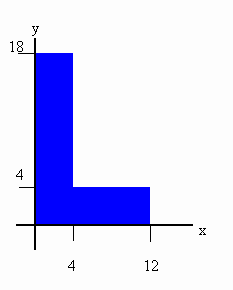
Solution:
- Concepts:
The center of mass
- Reasoning:
We are asked to find the CM of an object.
We can think of the system as being made up of two subsystems, as shown in
the figure.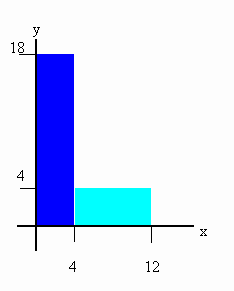
The CM of the left subsystem lies at xCM = 2 cm, yCM
= 9 cm. The CM of the right subsystem lies at xCM = 8 cm,
yCM = 2 cm. If the mass of a 1 cm by 1 cm square is 1 unit, then
the mass of the left subsystem is 72 units and the mass of the right
subsystem is 32 units. We find the CM of the system by treating each
subsystem as a separate particle, with all its mass concentrated at its
center of mass.
- Details of the calculation:
xCM = (72 units 2 cm + 32 units 8 cm)/(104 units) = 3.85 cm,
yCM = (72 units 9 cm + 32 units 2 cm)/(104units) = 6.85 cm.
The CM of the system lies outside of the system. For irregular-shaped
objects it is quite common for the CM to lie outside the system. This
special point outside the system responds to external forces as if the total
mass of the system were concentrated there.
Moment of inertia
Problem:
The four particles in the figure below are connected by rigid rods.
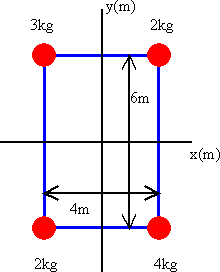
The origin is at the center of the rectangle. If the system rotates in
the x-y plane about the z-axis with an angular speed of 6 rad/s, calculate
(a) the moment of inertia of the system about the z-axis and
(b) the
rotational energy of the system.
Solution:
- Concepts:
The moment of inertia about an axis, the rotational
kinetic energy
- Reasoning:
The moment of inertia is I = ∑miri2.
Here ri is the perpendicular distance of particle i from the
z-axis.
the rotational kinetic energy, Trot = ½Iω2
- Details of the calculation:
Each particle is a distance r = (9 + 4)½
m = √(13) m from the axis of rotation.
I = (3 kg + 2 kg + 4 kg + 2
kg)(13 m2) = 1 43 kgm2.
(b) The rotational kinetic
energy is Trot = ½Iω2 = 71.5*36/s2 =
2574 J.
Problem:
Three particles are connected by rigid rods of negligible mass lying along
the y-axis as shown.

If the system rotates about the x-axis with angular speed of 2 rad/s, find
(a) the moment of inertia about the x-axis and the total rotational kinetic
energy evaluated from ½Iω2, and
(b) the linear speed of each particle and the total kinetic energy evaluated
from ∑½mivi2.
Solution:
- Concepts:
The moment of inertia of a system about an axis
- Reasoning:
The moment of inertia is I = ∑miri2.
Here ri is the perpendicular distance of particle i from the
x-axis.
- Details of the calculations:
(a) I = 4 kg 9 m2 + 2 kg 4 m2 + 3 kg 16 m2
= 92 kgm2.
The rotational kinetic energy is Trot = ½Iω2 =
46*4/s2 = 184 J.
(b) The linear speed of particle i is vi = ωri.
The linear speed of the 4 kg mass is v = 6 m/s, and its kinetic energy is
½mv2 = 72 J.
The linear speed of the 2 kg mass is v = 4 m/s, and its kinetic energy is
½mv2 = 16 J.
The linear speed of the 3 kg mass is v = 8 m/s, and its kinetic energy is
½mv2 = 96 J.
The sum of the kinetic energies of the three particles is 184 J.
Problem:
Two circular metal disks have the same mass M and the same thickness d. Disk
1 has a uniform density ρ1 which is less than ρ2, the
uniform density of disk 2. Which disk, if either, has the larger moment
of inertia about its symmetry axis perpendicular to the plane of the disk?
Solution:
- Concepts:
The moment of inertia
- Reasoning:
Let the radii of the disks be R1 and R2 respectively.
The disks have the same mass and thickness. Therefore ρ1R12
= ρ2R22.
The moments of inertia are I1 = MR12/2 and
I2 = MR22/2.
- Details of the calculation:
I1/I2 = R12/R22
= ρ2/ρ1.
Since ρ1 < ρ2, I1 > I2. Disk 1
has the larger moment of inertia.
Problem:
Consider a rigid body consisting of a collection of point masses mk
at positions rk in a body-fixed coordinate system. The system
rotates with angular velocity
Ω
about an axis which passes through the origin of the space-fixed coordinate
system. The angular momentum of the system about the origin is
L = Σkrk×pk = Σkmkrk×vk
= Σkmkrk×(Ω × rk).
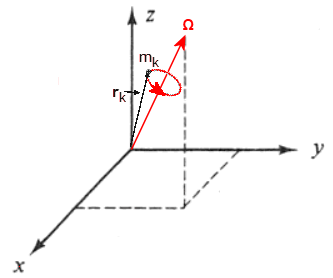
(a) Define the Cartesian components Iij (i, j = x, y, z) of
the inertia tensor, so that Li = ΣjIijΩj,
where the Ωj are the components of Ω along the
body-fixed axes.
(b) Now assume a continuous mass distribution of uniform mass density
ρ in a volume V having angular velocity
Ω
about an axis which passes through the origin.
Define the Cartesian components Iij of of the inertia tensor for this
mass distribution.
Solution:
- Concepts:
The moment of inertia tensor.
- Reasoning:
We are asked to define the moment of inertia tensor for a
discrete and a continuous mass distribution.
- Details of the calculation:
(a)
L = Σkmkrk×(Ω ×
rk)
= Σkmk[rk2Ω -
rk(rk·Ω)].
[A × (B ×
C) = (A·C)B
- (A·B)C]
We write this expression in component form.
Li = Σkmk[rk2Ωi -
(xk)i(rk·Ω)] = Σkmk[Σl(xk)l2Ωi -
(xk)iΣj(xk)j]Ωj],
or
Li = ΣjΣkmk[Σl(xk)l2δij
- (xk)i(xk)j]Ωj = ΣjIijΩj
Iij = Σkmk[Σl(xk)l2δij
- (xk)i(xk)j].
Ixx = Σkmk(yk2 + zk2),
Iyy = Σkmk(xk2 + zk2),
Izz = Σkmk(xk2 + yk2),
Ixy = Iyx = -Σkmkxkyk,
Ixz = Izx = -Σkmkxkzk,
Iyz = Izy = -Σkmkykzk.
(b) For a continuous mass distribution of uniform mass density ρ
L = ρ∫dV [r2Ω - r(r·Ω)],
and
Ixx = ρ∫dV (y2 + z2), Iyy =
ρ∫dV(x2 + z2), Izz = ρ∫dV(x2 +
y2),
Ixy = Iyx = -ρ∫dVxy, Ixz = Izx
= -ρ∫dVxz, Iyz = Izy = -ρ∫dVyz.
Problem:
A cylinder with radius r, height h, and mass M has uniform mass distribution.
(a) Find the Cartesian components Iij of its moment of inertia
tensor in the body-fixed coordinate system shown in the figure.
(b) If the cylinder is displaced along the z-axis so that its center of
mass is at the origin, find the components Iij in this new coordinate
system.
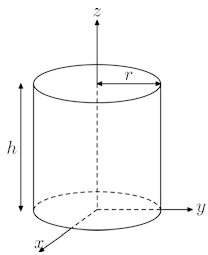
Solution:
- Concepts:
The moment of inertia tensor.
- Reasoning:
For a continuous mass distribution of uniform mass density ρ
Ixx = ρ∫dV (y2 + z2), Iyy =
ρ∫dV(x2 + z2), Izz = ρ∫dV(x2 +
y2),
Ixy = Iyx = -ρ∫dVxy, Ixz = Izx
= -ρ∫dVxz, Iyz = Izy = -ρ∫dVyz.
- Details of the calculation:
(a)
Here ρ = M/(πr2h) = constant.
From symmetry Ixy = Iyx = Ixz = Izx
= Iyz = Izy = 0. The coordinate axes are
principal axes.
I3 = Izz = ρ∫0hdz∫0rdr'
2πr'3 = 2πρhr4/4 = Mr2/2.
From symmetry Ixx = Iyy or I1 = I2.
2I1 = ρ∫dV (x2 + y2 + 2z2) =
Mr2/2 + 2ρ∫dV z2.
I1 = Mr2/4 + [M/(πr2h)]πr2∫0hdz
z2 = Mr2/4 + Mh2/3.
(b) The off-diagonal elements of the inertia tensor are still zero from
symmetry.
Parallel axis theorem: I'ii = Iii + M(a2
- ai2) = Iii + Ma⊥2
where Iii refers to a body-fixed coordinate system with the origin at
the CM and I'ij refers to a coordinate system with parallel axes and
a different origin.
Izz = I'zz = Mr2/2. Ixx = Iyy
= I'xx - Mh2/4 = Mr2/4 + Mh2/12.
Find the fraction of the kinetic energy that is
translational and rotational when
(a) a hoop
(b) a disc and
(c) a sphere rolls down an inclined plane of height h. Find the velocity at
the bottom in each case. Compare with a block sliding without friction down the
plane.
A uniform rectangular object of mass m with sides a and b (b > a) and
negligible thickness rotates with constant angular velocity ω about a diagonal
through the center. Ignore gravity.

(a) What are the principal axes and principal moments of inertia?
(b) What is the angular momentum vector in the body coordinate system?
(c) What external torque must be applied to keep the object rotating with
constant angular velocity about the diagonal?







